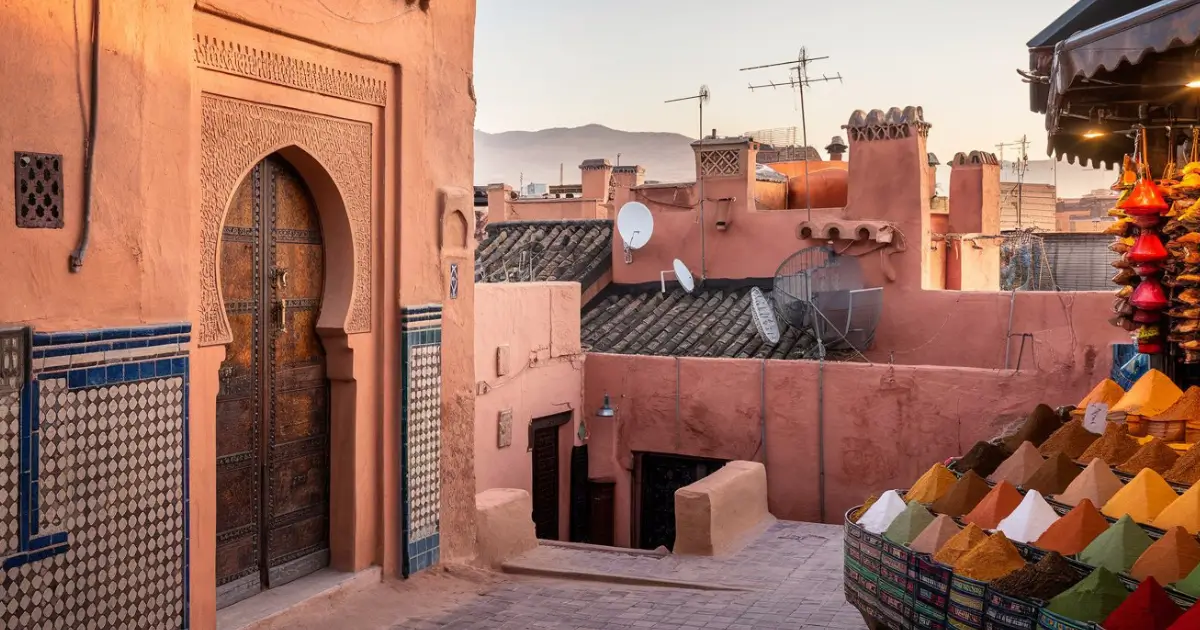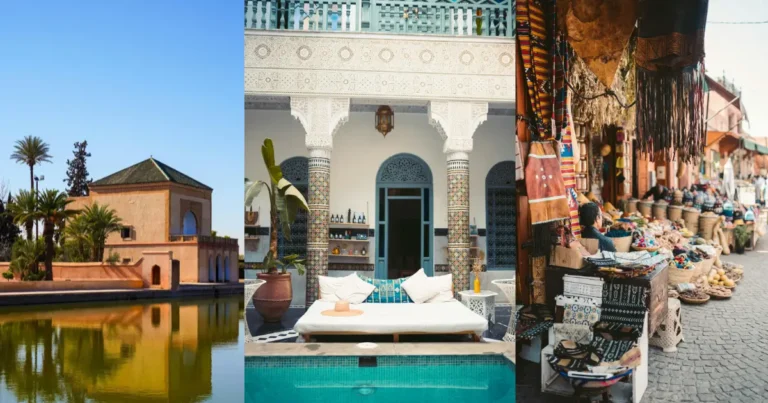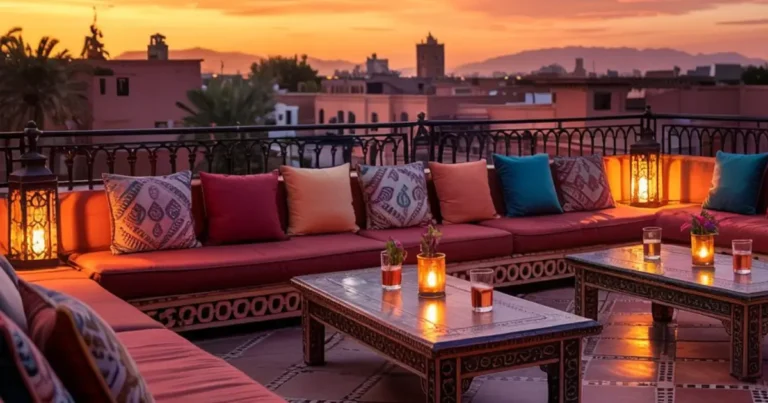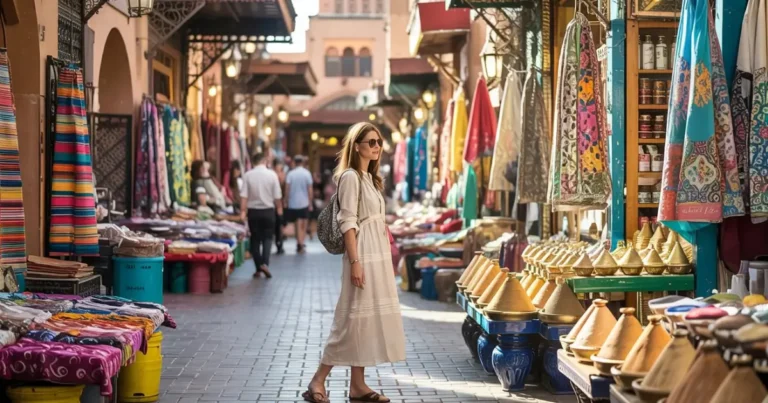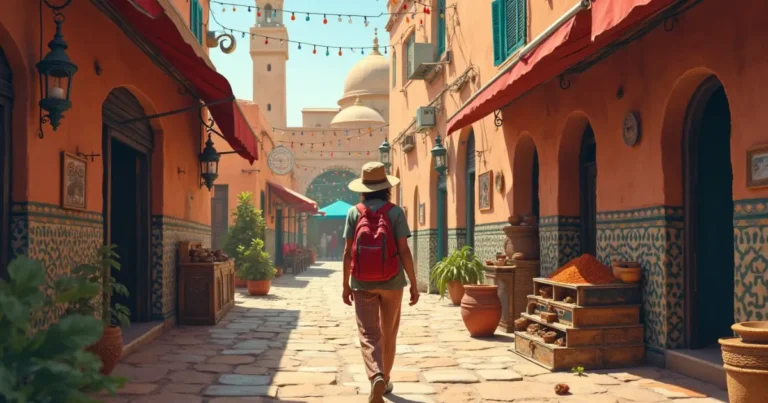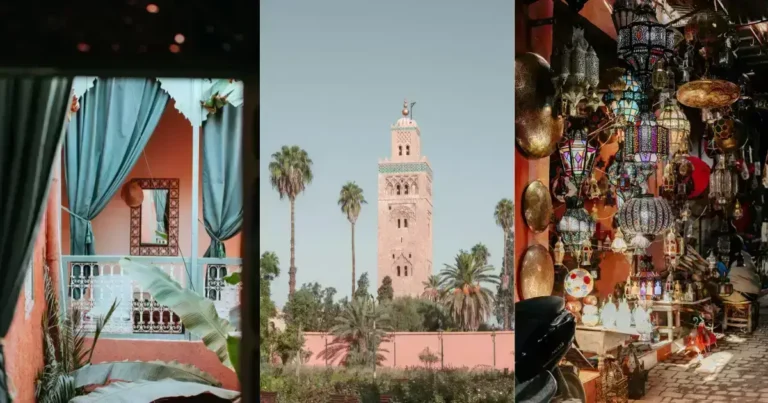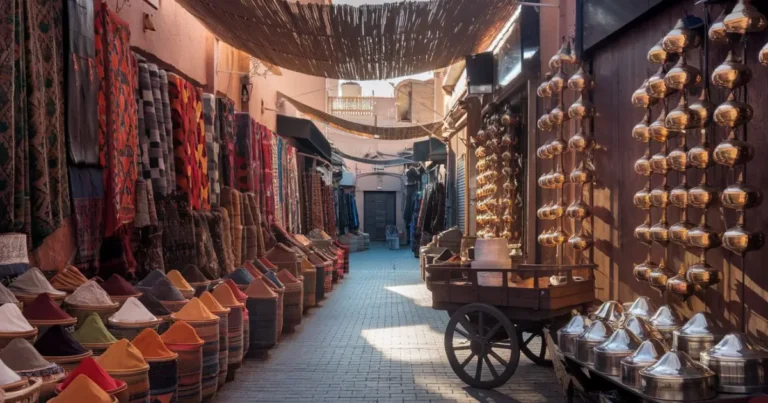Experiencing Marrakech Like a Local: The Ultimate Guide to Authentic Travel
Beyond the Tourist Trail
The allure of Marrakech extends far beyond its postcard-perfect riads and bustling main square. While these attractions certainly deserve their fame, there’s a profound richness to be discovered when you step away from the well-worn tourist paths and immerse yourself in the authentic rhythm of this ancient city.
If you’re yearning to bypass the tourist traps and experience Marrakech with genuine authenticity, this guide provides you with actionable steps and insider knowledge to do exactly that. Based on extensive on-the-ground research and insights from long-term residents, these recommendations will help you navigate the Red City with the confidence and awareness of someone who truly belongs.
Understanding the “Local” Mindset
Experiencing Marrakech like a local isn’t simply about visiting different places it’s about adopting a different approach to the city entirely. To truly connect with the authentic Marrakech experience, consider these foundational principles:
- Respect – The cornerstone of Moroccan culture is respect for others, particularly elders and traditions. This manifests in greetings, conversation, and public behavior.
- Patience – Life moves at its own pace in Marrakech. Embracing this unhurried rhythm is essential to experiencing the city authentically.
- Observation – Before participating, take time to observe local customs and behaviors. Notice how Marrakshis interact with each other and their environment.
- Embracing Controlled Chaos – What might seem like disorder to Western eyes often has its own internal logic and rhythm. Learning to navigate this apparent chaos is part of the local experience.
- Relationship-Building – In Marrakech, relationships precede transactions. Taking time for tea, conversation, and connection isn’t just politeness—it’s the foundation of daily life.
“To understand Marrakech, you must surrender to its rhythm. The city doesn’t adapt to you; you adapt to it.” – Hassan, local tour guide and lifelong resident
Mastering the Medina & Beyond
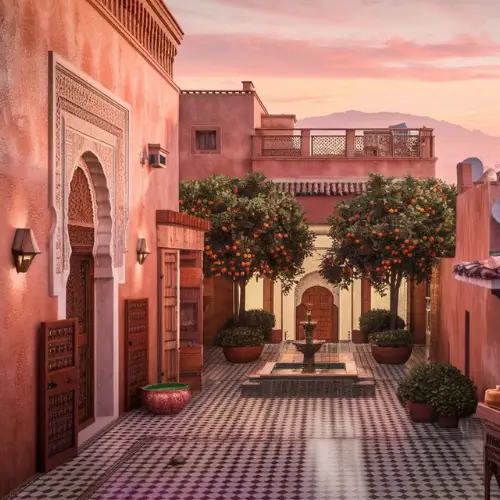
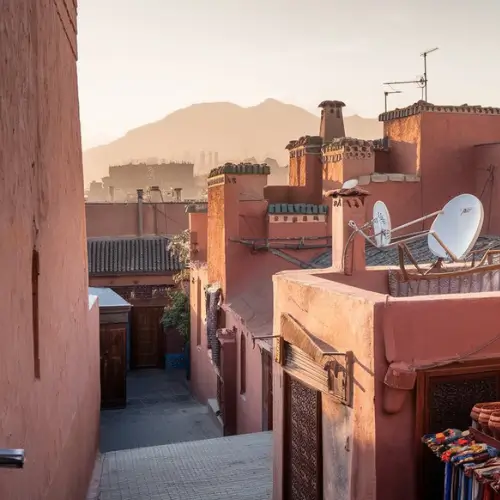
Beyond Djemaa el-Fna
While Djemaa el-Fna square is undeniably magnetic, venturing into these less-frequented neighborhoods will give you a more authentic glimpse of daily life:
- Kasbah – Beyond the tourist-heavy royal tombs, explore the residential areas where local families have lived for generations. The southern section particularly offers glimpses into everyday Marrakshi life.
- Mellah – The historic Jewish quarter contains fascinating architectural elements and a rich multicultural history. Wander its quieter streets to discover hidden courtyards and community bakeries.
- Gueliz – To experience modern local life, head to this French-built district where young Marrakshis shop, socialize, and dine. Visit Jardin El Harti in the late afternoon when locals gather for conversation.
Navigation Tips
Walking Strategies:
- Use the mountains as your constant north reference point
- Note distinctive shops rather than street names
- Walk with purpose but without hurry
- If lost, ask shopkeepers (not street guides) for directions
Petit Taxi Etiquette:
- Insist on using the meter (عداد / “adad”)
- Know that sharing taxis is common practice
- Typical local fare within the city should be 20-40 dirhams
- Popular local routes include Gueliz to Medina (about 25 dirhams)
Essential Darija for Directions:
- “Sir neeshan” – Go straight
- “Dur limn/lisr” – Turn right/left
- “Bshhal l…” – How much to… (location)
- “Wqef hna, afak” – Stop here, please
Local Transit Options:
- Bus #1 connects major neighborhoods for just 4 dirhams
- For areas like Majorelle Gardens, locals use petit taxis but negotiate before entering
Eating & Drinking Like a Marrakshi
Beyond the Tourist Tagine
Forget the restaurants in your guidebook and seek out these authentic local eateries:
| Type of Dining | Local Recommendation | What to Order | Price Range |
|---|---|---|---|
| Breakfast | Café du Grand Balcon | Bissara (fava bean soup) with olive oil | 15-25 MAD |
| Lunch | Restaurant Naima (near Bab Doukkala) | Worker’s lunch menu with fresh bread | 30-45 MAD |
| Dinner | Haj Mustapha (Rue Dar el Bacha) | Authentic tanjia marrakchia | 60-80 MAD |
| Street Food | Stalls behind Koutoubia | Fresh msemen with honey | 10 MAD |
| Local Hangout | Café des Épices (locals use upstairs) | Mint tea and people-watching | 15 MAD |
Street Food Deep Dive
The best street food experiences happen where locals eat. Look for these authentic specialties:
- Sfinge – Moroccan doughnuts, best from morning vendors near Bab Doukkala market
- Bocadillos – Sandwich-like creations; try the tiny shop on Rue Mouassine where workers line up
- Makouda – Potato fritters served with harissa, found at stalls near the local markets
Safety Tip: Look for vendors with high turnover and local customers, especially women and children. Food cooked fresh in front of you is generally safest.
Market Food Shopping
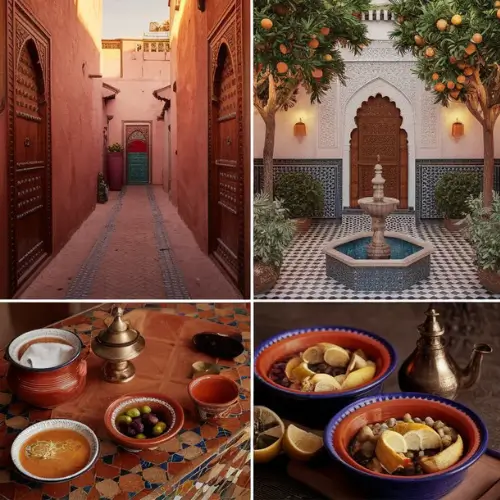
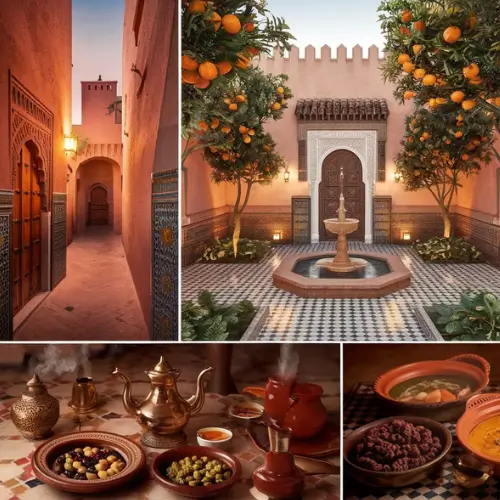
Skip the tourist-oriented spice souks and shop where locals do:
- Marché Municipal in Gueliz for fresh produce
- Souk El Khemis (Thursday Market) for olives, preserved lemons, and local cheese
- Bab Doukkala Market in the morning for breads and breakfast items
Cafe Culture
Cafe life is central to Marrakech social structure. To participate authentically:
- Visit cafes between 5-7pm when locals gather after work
- Order “nos-nos” (half coffee, half milk) rather than tourist-oriented drinks
- Try Cafe Clock’s back courtyard or Café des Épices’ upper terrace for authentic atmosphere without tourist prices
Drinking Protocols
- Non-Alcoholic: Fresh juices from stalls on Rue de la Kasbah; avocado juice with milk is a local favorite
- Alcoholic: While less common, locals who drink often visit Kosy Bar or Café Arabe’s terrace. Order local Flag beer rather than imported options.
Shopping Authentically
Souk Strategy
Advanced Bargaining Etiquette:
- Begin with “salaam alaikum” and small talk
- Don’t haggle on basic food items with set prices
- For crafts, counter with 40-50% of initial asking price
- Walk away politely if needed; being invited back is part of the dance
- When price is agreed, commit with good grace
Finding Quality:
- Look for workshops behind shops where actual production happens
- Quality leather smells distinctly (not chemically)
- Real silver has a government stamp
- Hand-painted ceramics have slight imperfections in patterns
Artisan Districts
For more authentic shopping experiences, visit these specialized areas:
- Sidi Youssef Ben Ali district for metalworkers creating authentic lanterns
- Rue Dar el Bacha for quality leather goods beyond the tourist shops
- Women’s Cooperative d’Al Kawtar for textiles made by local women (fixed prices support fair labor)
Fixed Price Alternatives
When you prefer straightforward shopping:
- Ensemble Artisanal offers government-regulated fair prices for authentic crafts
- Souk Cherifia houses young Moroccan designers creating contemporary pieces with traditional techniques
- Gueliz boutiques where fashion-conscious locals shop for modern interpretations of traditional designs
Immersing in Culture & Daily Life
Hammam Etiquette Explained
Follow this step-by-step guide to use a local hammam like a Marrakshi:
- Preparation: Bring plastic sandals, your own soap (preferably black soap or “savon beldi”), a small bucket, and a “kessa” exfoliating glove
- Entrance: Pay the attendant (typically 10-20 dirhams for local hammams)
- Changing: Undress to underwear (women) or shorts (men)
- Washing Process:
- Begin in the warm room to acclimate
- Move to hot room and wet your body
- Apply black soap and let it sit for 10 minutes
- Have an attendant scrub you with the kessa (30-50 dirhams) or do it yourself
- Rinse thoroughly using your bucket
- Completion: Rest in the cool room before dressing
Recommended local hammams include Hammam Dar el Bacha for women and Hammam Bab Doukkala for men.
Essential Darija Phrases
| Purpose | Phrase | Pronunciation | Meaning |
|---|---|---|---|
| Greeting | “Labas?” | la-bass | How are you? |
| Response | “Hamdullah” | ham-du-lah | Good, thank God |
| Shopping | “Bshhal hada?” | bsh-hal ha-da | How much is this? |
| Negotiating | “Ghali bezzaf” | rah-lee bez-zaf | Too expensive |
| Appreciation | “Mezian” | mez-yan | Good/nice |
| Gratitude | “Shukran bezzaf” | shuk-ran bez-zaf | Thank you very much |
| Direction | “Fin…” | feen | Where is… |
| Food | “Bssaha” | be-sa-ha | Enjoy your meal |
Social Etiquette
- Greetings: Always begin interactions with “Salaam alaikum” and inquiries about family
- Dress Code: Women should cover shoulders and knees; men should avoid shorts in religious areas
- Religious Respect: Walk around (never through) prayer gatherings; avoid eating/drinking publicly during Ramadan
- Home Invitations: Bring a small gift (pastries or fruit); remove shoes when indicated; compliment the home
- Time Concept: Arrive 15-30 minutes later than stated time for social gatherings (but be punctual for business)
Finding Local Experiences
- Sports: Watch local football matches at Grand Stade de Marrakech (tickets from 30 dirhams)
- Gardens: Visit Arsat Moulay Abdesalam on weekends when local families picnic
- Music: Check out Café Clock’s community performances featuring local musicians
- Community: The public library near Koutoubia often hosts cultural events open to visitors
- Markets: Shop at weekly souks on the city outskirts, particularly Thursday and Sunday markets
Practicalities for the Savvy Traveler
Safety Nuances
- Medina at Night: Main paths remain safe; carry a flashlight for unlit areas
- Common Scams: Beware of “guides” saying destinations are closed; politely decline with “La shukran, ana aref tariq” (No thanks, I know the way)
- Photography: Ask permission before photographing people; small tip (5 dirhams) is appreciated
- Valuables: Carry only what you need; front pockets for money; crossbody bags kept in front
Connectivity
- Local SIMs: Purchase from Maroc Telecom shops in Gueliz (bring passport); “Jawal Pass” for 100 dirhams includes 10GB data
- WiFi Access: Most cafes offer free WiFi with purchase; password usually on receipt
- Power: Outlets are European standard; public charging rare except in modern cafes
Best Times to Visit (Local Perspective)
- Peak Local Experience: Mid-April to May (before summer heat) or September to October
- Weather Considerations: Avoid August (extremely hot) and January (can be surprisingly cold/wet)
- Local Festivals: Plan around Ramadan (for unique evening atmosphere) or the Festival of Roses (May)
Local Voices
“Tourists rush through our city collecting photos, but to truly know Marrakech, you must sit still long enough to let it reveal itself to you.” – Fatima, spice vendor near Bab Doukkala
“The difference between tourists and travelers is simple: tourists want Marrakech to adapt to them; travelers adapt themselves to Marrakech.” – Mohammed, riad manager in the old Medina
“Don’t try to ‘do’ Marrakech in two days. The beauty is in the small moments—morning light on ancient walls, the call to prayer at sunset, conversations with shopkeepers who become friends.” – Yasmine, local artist
Conclusion: Becoming Part of the Tapestry
Experiencing Marrakech like a local isn’t about ticking off a different set of attractions—it’s about embracing a different way of moving through the world. The authentic Marrakech experience comes from slowing down, observing carefully, and participating respectfully in the daily rhythms of this extraordinary city.
By following these local tips for Marrakech, you’ll discover a richer, more meaningful connection to a place that has fascinated travelers for centuries. You’ll return home with more than photographs—you’ll carry memories of authentic connections and unexpected discoveries that define truly transformative travel.
Have you discovered your own local gems in Marrakech? Share your authentic Marrakech experience in the comments below!
Save this guide for your trip and check out our detailed companion piece on Marrakech street food traditions to complete your local experience.
About the Author: This guide was developed through extensive research and collaboration with Marrakech residents who generously shared their insights into authentic local life.

